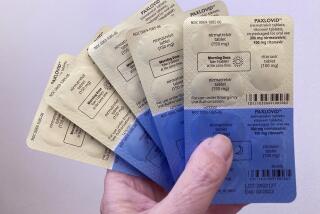AIDS Drug ‘Failures’ May Be Successes
- Share via
Many apparent “failures” in the treatment of HIV-positive individuals with new drug regimens may actually be unrecognized successes, according to Swiss researchers.
Combinations of three or more drugs now used to treat such patients have been highly effective, but many cases are considered failures because the level of virus in their blood does not fall below the limits of detection.
But the Swiss team reports today in the medical journal Lancet that such patients actually derive major health benefits by continued treatment with the drug combinations. Not only do their levels of the AIDS virus remain steady over the long term, their levels of CD4 cells--an indicator of immune system health--increase.
“This observation challenges our understanding of the mechanisms of immune damage due to HIV, and opens the door towards new therapeutic approaches,” said Michael P. Glauser, chairman of the Swiss Commission for Research on AIDS.
Some American researchers said they had observed such results, but apparently no one had reported them in a publication.
“It’s a hopeful message,” said Dr. Robert T. Schooley of the University of Colorado Health Sciences Center in Denver. “It should make patients feel better to know that they are going to benefit from the therapy even if the virus is not completely suppressed.”
In a related development that could dramatically reduce the incidence of AIDS in children, the British pharmaceutical company Glaxo-Wellcome PLC said Thursday that it will slash the price of the anti-AIDS drug AZT by as much as 75% in developing countries.
The adoption three years ago of triple therapy--a combination of two antiviral drugs, such as AZT, plus one member of a new family of drugs called protease inhibitors--revolutionized the treatment of AIDS.
The combinations can reduce the level of virus in a patient’s blood below detectable limits. This suppression has been accompanied by lower death rates, decreased hospitalizations and the return of many severely ill patients to good health.
Triple therapy is successful in more than 80% of patients who have never taken AIDS drugs. But among those HIV-positive people who have undergone previous therapy, the success rate may be no more than 50%, because the virus has mutated after being exposed to the earlier drugs and may be resistant.
Physicians consider the treatment a failure when it does not reduce viral levels below the limits of detection or when the levels rebound to detectability during therapy. Ideally, they try to switch the patient to a different combination, but for many people there are very few options. Because the drugs are toxic and expensive, treatment may occasionally be stopped completely.
The new results suggest that these failures may not be as devastating as many people had previously believed.
Dr. Amalio Telenti and his colleagues at the Centre Hospitalier Universitaire Vaudola in Lausanne studied 101 HIV-positive individuals undergoing triple therapy, all of whom had previous exposure to other AIDS drugs. The virus was undetectable in a third of the group, sporadically detectable in another third, and always detectable in the remainder.
They saw few other differences among the groups, however. All remained healthy, none showed a large viral rebound and all showed a rise in CD4 levels. But the increase in the number of CD4 cells in the third group was only about 75% to 80% of the increase in the other two groups.
The fact that CD4 levels rose in the patients with the virus is “potentially good news,” said Dr. Andrew Kaplan of the UCLA AIDS Institute. “Previously, we would have thought that if the viral load goes up, it is undeniable evidence that therapy has failed. This offers a ray of hope that if you continue on the medicine, you will get benefit from it.”
Telenti speculated that even though the virus is continuing to reproduce, it may have lost its ability to infect and destroy the CD4 cells. Alternatively, he suggested, the protease inhibitors may have a beneficial effect separate from their effect on viral suppression.
Schooley, however, said there is a much simpler explanation. The level of CD4 cells represents an equilibrium between production of the cells by the immune system and their destruction by the virus. If the level of virus is reduced, then the immune system can predominate and the level of CD4 cells will rise.
“You can do this without completely stopping viral replication,” he said. “In the old days when we were only using one drug, we would often see CD4 levels rise.”
The potential problem, Kaplan noted, is that as long as there is virus in the blood, the immune system will have to keep producing CD4 cells at a higher-than-normal rate. “Eventually,” he said, “you would think the immune system would get exhausted and the CD4 levels would drop again.”
But if triple therapy can keep patients relatively healthy for a couple of years, Telenti said, the patients may then have access to newer drugs that will control resistant viruses.
The announcement by Glaxo that it was reducing the price of AZT came just two weeks after federal researchers said that a short course of AZT could reduce the transmission of HIV from pregnant women to their infants by as much as 50%. About 600,000 children worldwide died last year from AIDS contracted during childbirth and most pregnant women received no treatment.
A longer course of AZT is used in this country and it has virtually eliminated maternal transmission of the disease, but it costs between $800 and $1,000--far too expensive for the Third World.
Experts hope that the reduced price for AZT will have a dramatic effect on childhood AIDS in poorer countries.






